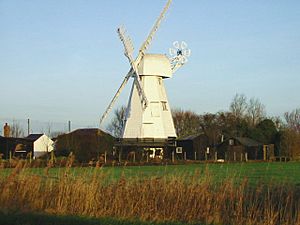White Mill, Sandwich facts for kids
Quick facts for kids White Mill, Sandwich |
|
|---|---|
 |
|
| Origin | |
| Mill name | White Mill |
| Mill location | Ash Road, Sandwich, Kent |
| Grid reference | TR 322 586 |
| Operator(s) | The White Mill Museum Trust Ltd |
| Year built | 1760 |
| Information | |
| Purpose | Corn mill |
| Type | Smock mill |
| Storeys | Three-storey smock |
| Base storeys | Single-storey base |
| Smock sides | Eight-sided |
| No. of sails | Four |
| Type of sails | Spring Sails |
| Windshaft | Cast iron |
| Winding | Fantail |
| Fantail blades | Six bladed |
| Auxiliary power | Engine |
| No. of pairs of millstones | Two pairs driven by wind, third pair driven by engine |
The White Mill is a special type of smock mill located west of Sandwich, in Kent, England. It was built a long time ago, in 1760. Today, this old mill has been fixed up and is open for everyone to visit. It's part of the White Mill Rural Heritage Centre.
The museum also includes the miller's cottage. This cottage has been decorated to look just like it did between 1900 and 1939. In other buildings nearby, you can see displays of old farming tools and craft tools. There are also workshops that show how a wheelwright (someone who makes wheels) and a blacksmith (someone who works with metal) used to do their jobs.
Contents
The Mill's Story
The White Mill was built in 1760. It appeared on old maps from 1769 and later maps from 1819 to 1843. The Stanley family worked at this mill for many years.
The mill stopped using wind power in 1926. After that, it was powered by a 28-horsepower oil engine until 1957.
Restoration Efforts
In the 1960s, a person named Vincent Pargeter helped repair the mill. He later became a professional millwright, which is someone who builds and repairs mills. Some sails from another mill that was taken down in Wingham were put on the White Mill.
At first, Mr. Pargeter paid for the repairs himself. But in 1964, a group called the Society for the Protection of Ancient Buildings gave money to buy materials for the mill's repairs. The Sandwich Borough Council bought the mill in 1968. Later, it became owned by Kent County Council.
In the early 2010s, a local group of volunteers called the White Mill Rural Heritage Centre started working to make the mill fully working again. In 2018, the top part of the mill, called the cap, was taken off for repairs. It was put back on in 2023. These repairs cost about £25,000.
How the Mill Works
The White Mill is a three-storey smock mill. This means it has three main levels. It sits on a single-storey brick base. The mill has four spring sails, which are the large arms that catch the wind.
The mill turns to face the wind using a special part called a fantail. This fantail has six blades. The mill uses wind power to turn two pairs of millstones. A third pair of millstones can be turned by an engine.
Much of the mill's inside machinery is made of wood. This includes the brake wheel, the wallower, the great spur wheel, and the stone nuts. The millstones are "overdrift," meaning they are turned from above.
Millers Who Worked Here
- Thomas Stanley (1878)
- Stanley Brothers
- Albert Stanley (until 1952)
Images for kids












